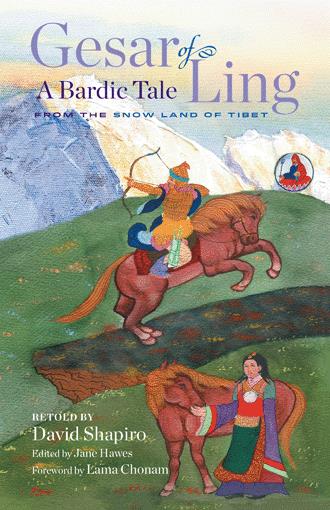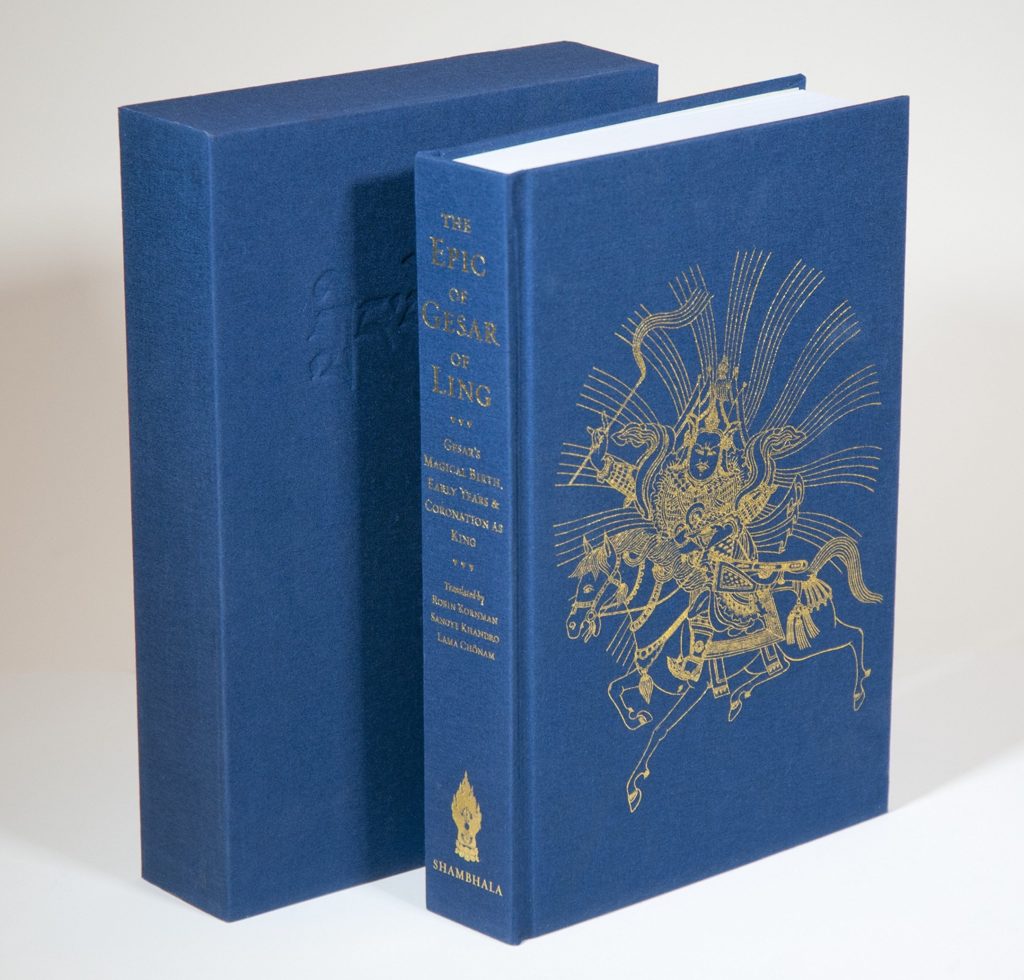
A Book Review from David Whitehorn
When I was asked to review the new Gesar book by David Shapiro my first thought was to say no. Although I have been a student of Tibetan Buddhism since I met Chogyam Trungpa in 1971, I am not a Tibetan scholar and my knowledge and understanding about Gesar or the epic tale of his life is quite superficial. But I did say yes and I am glad I did. It turned out that this book is an excellent resource for someone who, like me, has an interest but not much knowledge about Gesar and the world in which he lived.
In the introduction Dr. Shapiro clearly states that his goal is to make the Gesar epic more accessible to the contemporary western reader. To that end he has taken a book published in 2012 (Gesar of Ling: Gesar’s Magical Birth, Early Years and Coronation as King ) and revised it by eliminating technical terms and using a more conventional story structure.
I found a number of things in this book that were quite interesting and informative. First is the history of the Gesar epic, this book and the one it is based on. As explained in the introduction and foreword, the Gesar epic dates back at least a millennium and arose as an oral tradition carried on by traveling bards. It was only in the late 1800s that it was written down in Tibetan. Another milestone is the work of Robin Kornman, an early student of Chogyam Trungpa, Rinpoche, who translated the beginning section of the epic into English as his PhD thesis at Princeton in the early 1990s. In the mid-1990s Korman entered into a collaboration with Lama Sonam (who provided the foreword to this new book) and Sangye Khandro. This was fortunate in that, when Kornman died of cancer in 2007, his collaborators were able to continue the project and bring it to fruition as the 2012 publication. They were assisted by Jane Hawes in that work. Jane, as it happens, is married to David Shapiro and is listed as editor of the new book. In the foreword to the new book, Lama Sonam relates his own experience growing up in Tibet in the 1960s and reading the Gesar epic as a family activity. He sees the epic as a description of the culture and world view of the Tibetans of the past and worries that it is not being fully transmitted to current generations.

A second thing I learned was that Gesar was not an ordinary human being. His appearance in human form was the result of a carefully designed process managed by none other than Padmasambhava. According to the story, Gesar was sent to protect Tibet and Buddhism at a time when they were in danger.
A third thing I thought was quite interesting was the presence and central importance in the story of a number of powerful women. There is Gesar’s aunt Manene who appears at crucial moments to keep Gesar on track. There is his mother, the daughter of the Naga King, who is thrust into the role of giving birth to Gesar and steadfastly carries out not only that task but continues to support him as he grows up, despite all kind of tribulations. And then there is Princess Drukmo, Gesar’s wife to be, who encounters incredible challenges of all kinds, many of them awkward situations created by Gesar. In these stories Drukmo comes across as a genuine, courageous, wise and compassionate human being. Both she and his mother are essential to Gesar’s success, including being the ones who capture his magical horse for him.
Fourth, I was surprised that there was so much deception in these stories. Gesar was quite a trickster. He frequently created illusions that totally fooled everyone. These included times, including several encounters with Drukmo, when he would appear as someone else, creating very awkward situations for her. As well, Padmasambhava used deception, and even dirty tricks, in setting up the situation for the birth of Gesar.
Since reading the book I have been contemplating what to make of these stories. On the back of the book Sangye Khandro states that the epic sets forth the guidelines for basic human dignity and goodness in this world. However, the culture and world view that is revealed in the Gesar epic is clearly quite different from the dominant culture and world view we live with in 2019.
In the world of Gesar, human beings are influenced by unseen forces, some of which are beneficial and others are destructive. There is “magic” in everything. In contrast, the unseen has been stripped away in modern western civilization. It could be argued that this has led to a disconnect between humans and their environment, resulting in the degradation of both human interactions and the planet.
In that context, this very readable book is not only entertaining and informative but also offers the chance, if only briefly, to experience a world filled with magic and to consider how we might reconnect with the magic in our own world.
David Shapiro on “The Good Parts Version”
It is no coincidence that this book happened. No Coincidence at all. It is entirely possible that there was, very much in fact, no way to avoid it. As we know, Chogyam Trungpa and Gesar shared the Mukpo lineage, and Trungpa Rinpoche, like many or most Tibetans felt a strong connection to the Gesar Epic. Much of the language of Shambhala found its voice first within the historical bardic renditions of the Gesar Epic and well into the current era. This tale has been told and retold throughout the Tibetan Plateau. Today it continues as a cultural reference of great spiritual and historical import for the Tibetan people. It would not be an exaggeration to say that apart from the Dalai Lama, there may be no reference of greater import for the promotion and understanding of Tibet and its people. For students of Shambhala and of the Vidyadhara, having a clear understanding of the Epic and its history, its content and the sense of its meaning is critical.
It is no coincidence either that very early on, as the Nalanda Translation Committee was being formed, one of its founding members, Robin Kornman, became particularly entranced with the story of Gesar. Being a student of multiple languages and a deep reader of the world’s great literature, Robin was so taken with the epic that a first time ever Tibetan-to-English translation of the first volumes of the epic formed the basis of his PhD dissertation in comparative literature. While it was rather rough at that time, it being completed in 1992, over the years that followed it became refined. Robin moved to Milwaukee following the completion of his degree as he was awarded a three year endowed chair in the humanities department of the University of Wisconsin-Milwaukee. Ever gregarious and energetic, he formed a nucleus of students and began teaching Tibetan as well as beginning a partnership with Sangye Khandro and Lama Chonam who traveled for many months a year from 1995 to 1999 to Milwaukee, living in a flat above Robin and refining and translating the first three volumes of the Epic which deals with Gesar’s birth, early years and eventual ascendancy to be the leader of Tibet. A more refined, but still rough translation was finished by the late 1990s. Life being complex, the project was put on hold in this rough stage and then a few years later Robin became ill with the abdomenal mesothieloma which he battled and then succumbed to in 2007.
After his death one of his Tibetan students who happened to be my wife, Jane Hawes, was approached to look at the Gesar material, with which she was by then quite familiar. After a meeting with Lama Chonam and Sangye Khandro at Tashi Choling in Oregon, the project was restarted with Jane reviewing a few hundred hours of cassette tapes of all of the translation meetings that had occurred.
Transcribing them with the help of one of her daughters, and reviewing extensively by phone with Lama Chonam, an edition ready for copy editing was created. Much of the style of this book, which was published by Shambhala in 2012 as Gesar of Ling: His Magical Birth, Early Years, and Coronation as King, was driven by Robin’s desire for a text that would hold up to the academic standards of translation to which he had become accustomed. Though faithful to the original text, some of the bardic qualities so present in Gesar performances were lessened.
When the original book was being prepared and published, it was bandied about that, being a mythic-fantasy type tale, as are all epics, there would be other forms in which it could be produced. Robin being Robin, liked to envision the epic as perhaps a video game, a TV series, maybe similar to his beloved Buffy the Vampire Slayer, a graphic novel or a full length feature movie—all venues with the ability to heighten the storytelling aspect of the epic. Eventually it was suggested that I might try a version for young adults which was soon broadened to include all people over the age of say five, as it seemed unnecessary to in any way simplify or sanitize the text, not that current young adult literature is either of those things. And so the current text was begun, with the text published by Shambhala as a guide, the prose was reconstructed while the proverbs and verse was left more or less intact, though many of the songs were shortened or eliminated.
As a brief aside, the other day I was sitting on my son’s couch and picked up an old paperback version of William Goldman’s The Princess Bride and noted that he actually calls it “An Illustrated Edition of S. Morgenstern’s Classic Tale of True Love and High Adventure: The Good Parts Version.” Abridged by William Goldman. So it is that with sincere apologies to William Goldman, here I will leave you to this ‘good parts’ version. May the aspirations and desires of all beings be mostly fulfilled. At least the good and nice ones. -David Shapiro
David Shapiro became a student of Chogyam Trungpa Rinpoche in 1973 and was the founder-director of the Milwaukee Dharmadhatu (now the Milwaukee Shambhala Center). He was a practicing internist for 35 years and now lives in California with his wife.
















